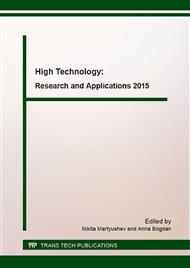p.505
p.511
p.516
p.521
p.525
p.530
p.534
p.539
p.543
Influence of Severe Plastic Deformation on Physicomechanical Properties of Ti-40 mas % Nb Alloy
Abstract:
The changes of the phase composition, structure and physicomechanical properties of Ti‑40 mas % Nb after severe plastic deformation are investigated in this paper. By the methods of microstructural, X-ray diffraction analysis and scanning electron microscopy it is determined that phase and structural transformations occur simultaneously in the alloy after severe plastic deformation. The martensitic structure formed after tempering disappears. The inverse α'' → β transformation occurs. The structure consisting of oriented refined grains is formed. The alloy is hardened due to the cold working. The Young modulus is equal to 79 GPa and it is less than that of initial alloy and close to the value obtained after tempering. It is possible that Young modulus is reduced by additional annealing.
Info:
Periodical:
Pages:
525-529
Citation:
Online since:
February 2016
Price:
Сopyright:
© 2016 Trans Tech Publications Ltd. All Rights Reserved
Share:
Citation:


